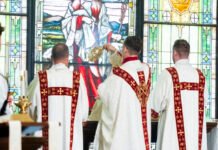The COVID-19 pandemic saw a significant decline in church attendance, marking a “radical discontinuity” even with previous downward trends, the Anglican Church of Canada’s statistics officer says.
Canon Neil Elliot presented data from 2022 diocesan returns in a January report sent to bishops and diocesan executive officers based on parish statistics. The statistics officer said he did not collect numbers in 2020 and 2021 since COVID-19 shut down churches for much of that time.
The figures show a decline on almost all fronts from 2019 to 2022, including a 12 per cent decrease in the total number on parish rolls, 26 per cent decrease in average Sunday attendance, and 17 per cent decrease in regular identifiable givers. The biggest drops came in the number of people attending services on major holy days: a 45 per cent decline in Easter attendance, 37 per cent for Pentecost and 47 per cent for Christmas.
Declines were also seen in the number of pastoral services, with 25 per cent fewer baptisms, 13 per cent fewer confirmations and 10 per cent fewer marriages—the only exception being funerals, which saw a very small increase.
“Attendance has been hit,” Elliot said. “I think that’s a really clear thing.”
Statistics for Easter and Christmas, Elliot said, are significant as an indicator of people from outside the regular parish community coming in for services.
Elliot said the pandemic has accelerated changes already happening within the church. From 1980 to 2019, he said, church statistics showed a straight line of decline. In a 2019 report to Council of General Synod, Elliot projected that based on that trajectory, there would be “no members, attenders or givers in the Anglican Church of Canada by approximately 2040.”
The figures from 2019 to 2022, however, show a change in that trajectory— specifically, an accelerated decline.
“What’s now happened is a radical discontinuity,” Elliot said. “What we don’t know is what will happen next.”

Asked about the impact of the pandemic on church attendance, Elliot said, “My thesis is that it has broken the habit of church for a number of people— people who were just in a routine of going to church. They went through the pandemic and then they decided, ‘No, don’t need to do this anymore.’ But there is no evidence for that.”
Comparing to other churches and denominations, the Anglican Church of Canada’s experience in this period has been typical, Elliot said. The Canadian church’s membership decline parallels those of the Church of England and The Episcopal Church, with its attendance decline sitting between the two. While the United Church of Canada has seen a much lower decline in average attendance, decline in Presbyterian church attendance exceeds that of the Anglican Church of Canada.
Conversely, in what the report describes as “genuinely good news,” provision of online services has been stabilizing, with about one-third of parishes offering them. The number of parishes with online services peaked at 749 in 2020—about half of parishes—then dropped to 562 (out of 1,486 total parishes) in 2021 and 548 (out of 1,498 total parishes) in 2022.
“Anecdotally, there were very few Anglican churches running online services before the pandemic, and the pandemic pushed us into running online services… Assuming that we keep at roughly that level, I hope that that means that we are doing outreach to a whole bunch of people who previously would not have been able to access a service of any kind,” Elliot said, offering the example of seniors who can now attend services online.
The latest statistics also offer a snapshot of the number of bishops, paid and unpaid priests and deacons, and paid diocesan workers which varies widely between dioceses. While numbers of lay readers and parish lay workers are falling, more than two-thirds of parishes have a paid priest, which Elliot said is encouraging. But he added, “We’re relying more on retired priests,” with almost one retired priest per parish.
Read it all in the Anglican Journal



